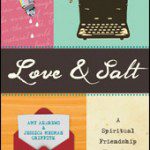 A Review of Love & Salt: A Spiritual Friendship Shared in Letters
A Review of Love & Salt: A Spiritual Friendship Shared in Letters
By Amy Andrews and Jessica Mesman Griffith
As we take the turn into Lent very soon, we are blessed to be given a window into a spiritual friendship that uses the age-old practice of letter writing as a mode of mutual spiritual direction. These two young women, each an accomplished writer and reader, choose as a Lenten discipline to write to each other every day of Lent, for one in a preparation for her conversion into the Roman Catholic church, the other as her sponsor. By taking the time and effort to put pen to paper rather than to use more “efficient” and speedy methods of communication, these two don’t have the immediate gratification of Q and A, or statement and immediate response. However, what we the readers all these years later are given is, as these two continue the practice over time, a body of organic and considered sacred conversation about what is for each of them, the heart of the matter in their faith journey.
The story of their connection from meeting to becoming soul friends provides the context for this friendship, and surely there are points of affinity that make for intuitive and deep communication between them. Their theological ponderings, their struggles with living what they have come to believe, and the challenge of keeping faith against the background of quotidian annoyances and detours stretch this friendship from the tedious to the sublime, and from disappointment to joy. Here they enter into a phrase borrowed from Aristotle in which he writes that friendship requires that “they cannot know each other well until they have consumed much salt.” In the “eating much salt” as well as sharing deep love, they come to know the love of God for each of them and for the world.
The dramatic arc of the story takes these women through the delight of a shared journey, through the suffering of hopes deferred, and most powerfully, into shared tragedy and loss. Here is where the sacred conversation becomes the crucible in which their faith journey is shaped and purified. They very generously share snippets of letters, both sent and unsent, in and around this period, each revealing her own doubt, anger, despair, what I would call wrestling with God. “It makes me cry right now to think of you weeping in secret. So let it be as it is: a time of eating much salt, alone and together…Yet this time is not merely that. I see that I still love you, take pleasure in your ways, and yearn for your good and mine.” (Andrews, 238). To see that spiritual friendship can bear and sustain “eating much salt” together is poignant and powerful example of what the Spirit does when two come together in Christ’s name.
In reading this book I found myself longing for all people of faith to have or to take this kind of opportunity to choose a spiritual practice that would slow them down enough to articulate and to hear what the Spirit was at saying to them in their own heart and the heart of another. Sometimes this happens in spiritual direction, sometimes in small groups, but the choice to write letters imposes on these writers a discipline of word that refines and winnows their own faith, while, at the same time, giving presence and encouragement to the partner in faith. This example of busy people, finding sacred rhythm to the calls of parenting, writing, companion by sharing the search with another is exemplary and challenging. I am glad we now have this model of spiritual practice to consider afresh.
To read an excerpt from Love & Salt, and for more conversation about the book, visit the Patheos Book Club here.
 Elizabeth Nordquist is a pastor, a teacher, a spiritual director, a family lover and a friend. She has written articles for the Presbyterian Church (USA), and preaches and teaches in a variety of places where she is called.
Elizabeth Nordquist is a pastor, a teacher, a spiritual director, a family lover and a friend. She has written articles for the Presbyterian Church (USA), and preaches and teaches in a variety of places where she is called.













